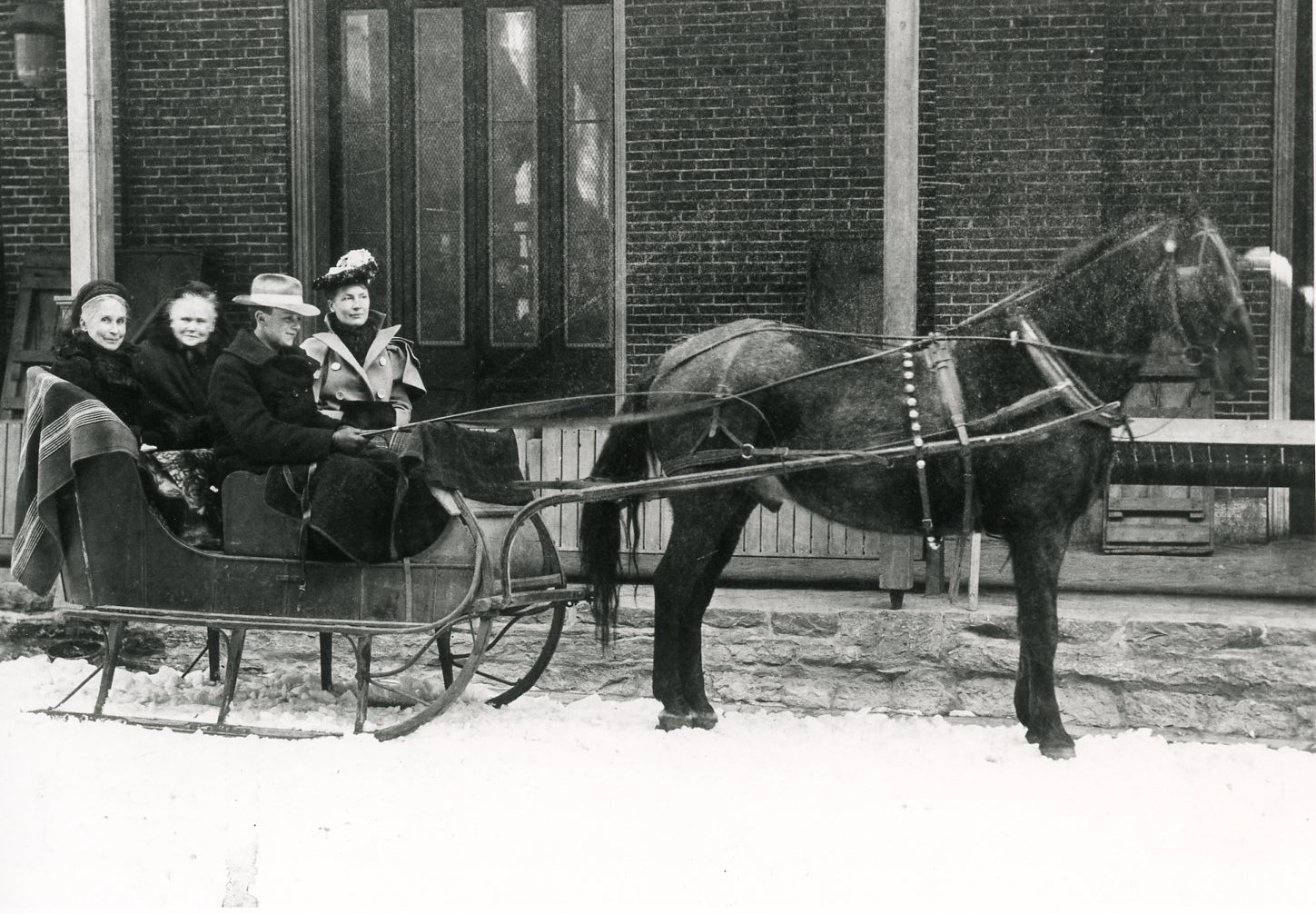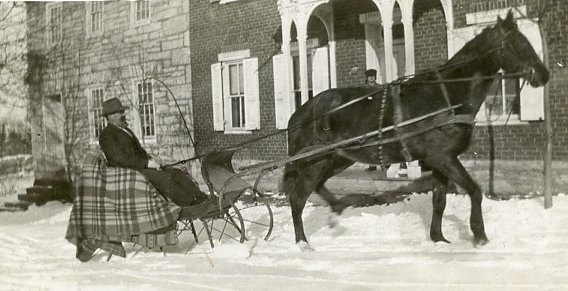Cumberland County Place Names
Cumberland County place names under the following lists: named after the founder or an early settler, geographical/geological features, and miscellaneous.


Top: James Smith, Annie Hall Colwell, Mary Hall Colwell and Mary Cowdrey seated in the sleigh. Photo taken c. 1900 by J. H. Andrews of Carlisle. (23D-21-05 CCHS Photo Collection.)
Bottom: Abram George Myers in front of his home in Springfield, Photo c. 1905. (47Y-01-04 CCHS Photo Collection.)
Carlisle Weekly Herald, January 3, 1849
Two very heavy falls of snow within the last week have made glorious sleighing and found everybody in the humor to enjoy it. Everything in the shape of a sleigh has been put in requisition, and the jingle of the merry bells is an unceasing sound from ‘tosy morn to dewey eve,’ and then as the evenings are splendidly moonlit, the merriment only fairly commences. We hear extravagant praises of the sumptuoussuppers at Moore’s in Papertown Mount Holly Springs, which is a favorite resort, and at Jack Wilkins near Newville, whose hasty entertainments need only to be tasted to be approved.1 The sleighing, which promises to be of some week’s continuance under the present freezing weather, will be a profitable “Card” to these establishments and to the livery-men.
The Carlisle Weekly Herald reported: Sleighing parties are all the rage. Almost every evening one can see passing through the streets large two-or four-horse sleighs, crowded with belles and beaux on their way to Papertown, Mechanicsburg, or some of the popular resorts in sleighing time.2
The year 1856 was a wonderful year for sleighing in Cumberland County. The Shippensburg News reported in its March 16 edition,“Another fall of snow took place on Sunday last. There has been over seventy days of sleighing this winter, and we doubt whether the “oldest inhabitant” can remember a season equal to this.”
It was essential to wrap up as warmly as possible when sleighing. Capes and tippets topped with furs or buffalo robes were the suggested sleighing attire for ladies in the mid-nineteenth century. Fur collars, gloves and over shoes for both ladies and gentlemen were also essential. Blankets tucked around legs and footwarmers helped stave off frostbite.
Sleighing Accidents
Sleighing was fun, but also dangerous when you combined ice, snow, speed, horses, and humans. Caution was needed when sleighing on Carlisle’s High Street because of the trains that ran through town. Not only could horses get frightened by the noise of the train and run off, but the runners of sleighs could get caught on the tracks. On January 24, 1856, Michael G. Beltzhoover of Monroe Township was driving up High Street in his sleigh, accompanied by his daughter, while the morning train had just left the depot for Harrisburg. As the sleigh and the train approached each other, Beltzhoover’s horse took fright, jumped to one side, and raced across the tracks in front of the oncoming train. While the engineer tried to slow the train, Beltzhoover’s daughter leaped from the sleigh. Beltzhoover kept hold of the reins, and although he escaped the train, the horse dragged him a considerable distance. Beltzhoover was bruised, and his collar bone had broken when he hit the track, but both he and his daughter survived the accident.3
A party of twelve people returning home from dinner and a dance near Johnstown, Pennsylvania, were thrown out of their sleigh and landed in snow drifts in a ravine when their two-horse sleigh slid down a twenty-foot embankment, turned over, and landed on them. Most were in serious condition. Three were not expected to survive, and only four of the twelve escaped injury.4
On one occasion, a young lady from Cumberland County froze to death from sleighing. She complained to her companions that she was very cold. When they finally came to a tavern where they could warm up and take refreshment, she refused to get out of the sleigh, saying that she was comfortable. By the time they reached her home, she had to be helped out of the sleigh. In a stupor, she died a short while later.5
Sleighing accidents resulted in the deaths of horses as well as people. Newspaper accounts of these accidents report horses running off with or without their sleigh attached and crashing into trees and fences or falling down embankments. Some horses, forced to race at top speed which resulted in snow balling upon their feet, have fallen, fractured their limbs, and had to be killed.6
The number of articles about sleighing and sleighing accidents reported in the newspapers decreased sharply in the first decade of the 1900s as ever increasing numbers of automobiles appeared on the roads. Today, although most people will never see a real sleigh let alone ride in one, sleighing lives on in Christmas songs and Currier and Ives prints.
Cumberland County place names under the following lists: named after the founder or an early settler, geographical/geological features, and miscellaneous.
[1] See Gardner Library article about the life of “Black Jack Wilkins.”
[2] Carlisle Weekly Herald, February 4, 1857.
[3] Carlisle Weekly Herald, January 30, 1856.
[4] The Philadelphia Inquirer, February 20, 1910.
[5] Carlisle Weekly Herald (as copied from the Harrisburg Telegraph), January 23, 1856.
[6] United States Gazette, Philadelphia, January 23, 1836.